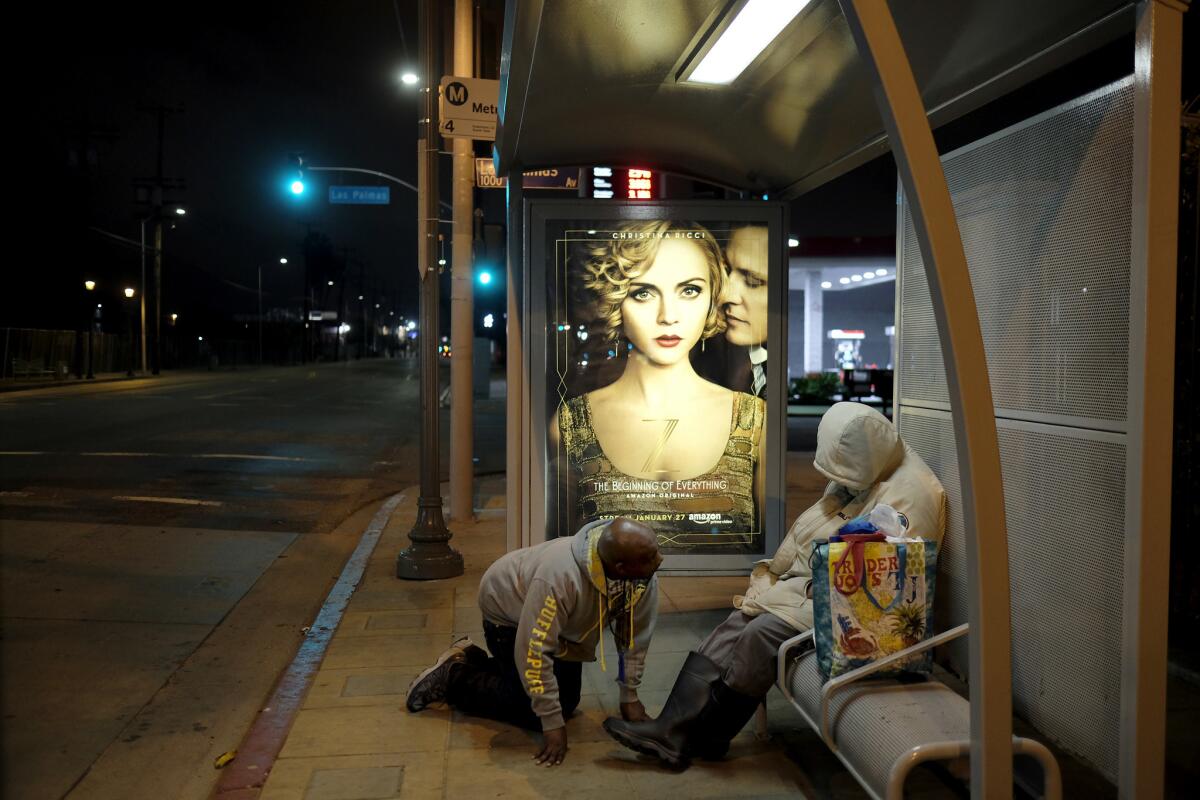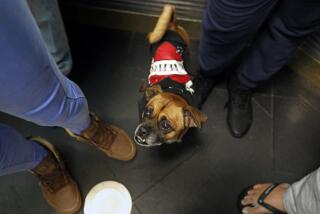Editorial: Can a neighborhood help one homeless woman? Here’s one that tried

The plea came across my Brentwood Nextdoor site on a cold December night:
“Will someone please go to the Ralphs at Wilshire and Bundy and provide some help to the homeless woman and her dog? It is raining and cold, and they are both wet and cold.” The writer continued: “I would help but I don’t have any money or resources…Please let’s act like we actually care and help this person out so she and her dog don’t succumb to exposure.”
Within 48 hours of that Dec. 4 post, people had transformed a website better known for complaints (and requests for a good mechanic or plumber) into a command center, marshaling resources for the woman, Debra, and her shaggy white dog, Happy. People volunteered clothing, food, dog food, blankets, toiletries, a rain slicker. Some delivered these supplies and spent time with her. She said she had been homeless for four years. “I spoke to Debra for a while today and she was super grateful,” one neighbor wrote.
The urgency of the mission was palpable. The city and county may be moving at a sluggish pace to build shelter and housing for homeless people, but there was no sluggishness in this effort.
By December 7, there were more than 100 comments on Nextdoor and two PayPal accounts had been established with several hundred dollars for three nights at local motels.
But things didn’t go as expected. People who had talked to Debra said she suddenly seemed agitated. “Everyone, it might be a good idea to refrain from approaching her or her dog for a while until her paranoia goes away,” one person urged. Eventually, she let someone drive her and Happy to a motel where a room had been reserved for her. But then she refused to stay at that motel or another one, saying she felt she was being followed and recorded on film.
“I feel perhaps it might be best to leave her be for now…” someone weighed in.
Someone on the string had asked if a social worker could help Debra. I emailed the St. Joseph Center, an agency that provides, among other services, outreach on the Westside.
Two days after she turned down the motel, the St. Joseph outreach workers successfully located Debra and Happy outside the Whole Foods in Brentwood. She chatted with them but turned down any kind of services. The team, which has training in dealing with mentally ill homeless people, reported that she appeared to be experiencing delusions. Several days later, the team found her a second time and suggested that coming into a service center or a shelter would mean a warm place for her dog as well. Still, she declined.
At a time when many L.A. residents have grown impatient with ever-present homeless people camped on their sidewalks, it was remarkable and heartening to see a group of strangers, moved by one plaintive online post, mobilize to get a homeless person into the refuge of a motel — and they almost succeeded.
Of course, it is true that helping one homeless woman and her dog is easier than figuring out what to do about tens of thousands of homeless people around the city and county. A lone woman and her dog in front of Ralphs are more approachable, and their problems more manageable, than those of dozens of destitute and despairing people in a crowded encampment beneath a freeway overpass. Still, I was inspired by how industriously my neighbors worked to improve Debra’s life even a little.
But, as you read this, she and Happy are probably still standing outside a grocery store or a drugstore or a library on the Westside. That’s because it can be extremely difficult to coax people who have been homeless for years into shelter, or to persuade them to trust outreach workers enough to accept whatever help they are offering. It can take six encounters, 15 encounters or more, to establish a rapport. If Debra had responded to the outreach workers, they had planned to put her in a motel and then, hopefully, take her to their homeless services center where she could be evaluated for mental and physical health services.
The outreach workers will approach her again at some point.
What outreach workers need are more spaces to house people. In this case, says the director of outreach at St. Joseph, that means more shelters on the Westside, including more shelters that take pets. The reality is that most homeless people won’t leave their pets, even for a roof over their heads.
“The day will come when she is ready to engage, and what do you do when you don’t have a resource for her?” says Heidi Marston, chief program officer of the L.A. Homeless Services Authority. It would be tragic if Debra finally connected with an outreach worker and they didn’t have a place for her.
Meanwhile, my online neighbors have not given up. On Thursday, someone spoke with Debra during the day but couldn’t find her later.
“I have a sleeping bag and a warm blanket for Happy but haven’t been able to locate her,” the person wrote. She asked others to message if they saw Debra. “It’s going to be cold tonight.”
More to Read
A cure for the common opinion
Get thought-provoking perspectives with our weekly newsletter.
You may occasionally receive promotional content from the Los Angeles Times.











